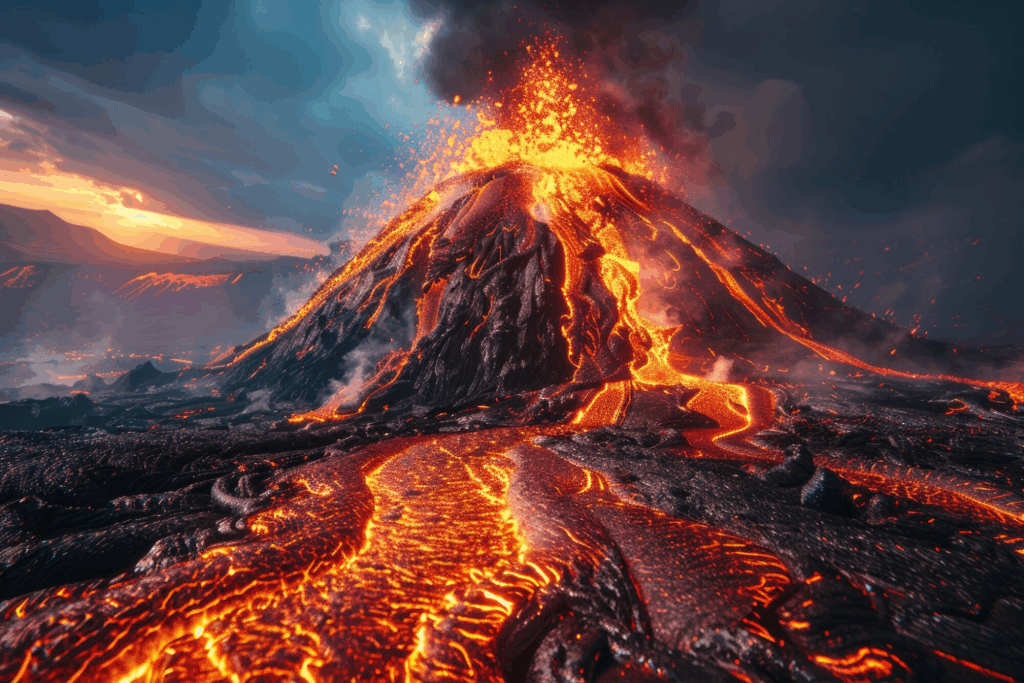The most active volcano in the Pacific Northwest may explode as early as tomorrow, according to a dire warning from scientists.
Located more than 4,900 feet below the Pacific Ocean’s surface and 300 miles off the coast of Oregon, the Axial Seamount is a mile-wide underwater volcano.
Magma surging to the surface has generated a huge increase in earthquakes beneath the seamount, according to researchers from the National Science Foundation’s Ocean Observatories Initiative.
William Wilcock, a marine geophysicist and lecturer at the University of Washington, claims that the seafloor has expanded to its pre-eruption level from 2015.
The bulge indicates the accumulation of extremely hot magma under the surface.

“At the moment, there are a couple hundred earthquakes a day, but that’s still a lot less than we saw before the previous eruption,” Wilcock explained.
According to the marine geophysicist, “I would say it was going to erupt sometime later (this year) or early 2026, but it could be tomorrow, because it’s completely unpredictable.”
When the Axial Seamount last erupted in 2015, it caused almost 8,000 earthquakes, 400-foot-thick lava flows, and a nearly eight-foot drop in the ocean floor.
In only the past month, the number of earthquakes in the area has increased significantly, with a notable peak in activity occurring on April 13.
The number of daily earthquakes beneath the seamount has been increasing gradually since May 6. Several of the
Experts suggest that human towns along the West Coast won’t be in danger if Axial Seamount blows in the coming days.
It has little effect on land-based seismic activity and is too deep and distant from the coast for anyone to even notice when it erupts.
However, as lava flows out of the seafloor volcano, the number of underwater earthquakes is predicted to increase dramatically during this event, from the couple hundred that occur every day currently to 10,000 within a 24-hour period, according to Interesting Engineering.
Axial Seamount is one of the best-monitored submarine volcanoes in the world, according to Mike Poland, a scientist with the Yellowstone Volcano Observatory, who expressed enthusiasm about the eruption.
“This particular volcano is probably the best-monitored submarine volcano in the world,” he told Cowboy State Daily. “It’s fascinating and doesn’t really pose a hazard.”
Axial Seamount is a young shield volcano, characterised by its low profile and wide shape, located in the Juan de Fuca Ridge, which is a chain of underwater volcanoes stretching between Oregon and Alaska.
“When Axial Seamount erupts, it’ll look a lot like a Hawaiian lava flow eruption,” Poland said.
“It’s not an explosive eruption, but calm effusions of lava flowing out of the caldera and across the seafloor.”
Last year, scientists issued a warning that by the end of 2025, Axial Seamount would erupt.
“Because it’s had these three eruptions in the last 30 years, that’s why we call it the most active volcano in the Pacific Northwest, because most of the ones on land aren’t active that frequently, and they spend a lot of their time slumbering, whereas Axial has a pretty active magma supply,” Chadwick told local CBS affiliate KOIN 6 News.
“So, if it’s not erupting, it’s inflating and getting ready for the next one. And so that’s why we’re kind of monitoring what’s happening to it all the time.”
“Axial Seamount has definitely erupted many times before those events, and eruptions were documented in 1998, 2011, and 2015,” Poland said.
William Chadwick, a geophysicist at Oregon State University, began studying the volcano in November 2024 after observing that its surface had risen to about the same height as it had before its most recent eruption ten years prior.
Chadwick and his colleagues were able to foresee the 2015 eruption based on the swelling that had already taken place.
They concluded that Axial Seamount would erupt before the end of 2025 based on their observations this time.
“Based on the current trends, and the assumption that Axial will be primed to erupt when it reaches the 2015 inflation threshold, our current eruption forecast window is between now (July 2024) and the end of 2025,” the researchers reported.
Additionally, they discovered that Axial Seamount was experiencing an increase in seismic activity, with hundreds of earthquakes and earthquake swarms exceeding 500 per day occurring around the volcano.
These and other frequent minor earthquakes can indicate the creep of magma locked beneath the ocean floor towards the surface.
In December 2024, the team presented their findings at the annual conference of the American Geophysical Union.
Wilcock pointed out that a significant rise in the frequency of earthquakes in the vicinity of the volcano, which is currently happening, would be the first indication that an eruption is about to occur.
“That period lasts about an hour, and then the magma reaches the surface,” Wilcock said in a statement last month.
After that, “the seismic activity dies down pretty quickly over the next few days, but the eruption will continue slowly for about a month,” he added.
For Wilcock and other scientists, the upcoming eruption will be a significant research opportunity. They intend to watch the eruption from beginning to end using an array of advanced instruments.
With networks of sensors spread across the ocean waters and along the bottom, the College of the Environment at the University of Washington is home to one of the biggest underwater observatories in the world.
Wilcock and his team will utilise this array to collect information and photos of the event as it happens when Axial Seamount explodes.
Although Axial is not a dangerous underwater volcano, scientists may be able to predict eruptions from others that are because to the forecasting skills they have developed from studying it.
For instance, the Hunga underwater volcano in the southern Pacific Ocean’s Tonga archipelago had a very strong eruption in January 2022, causing a tsunami that is believed to have cost $90 billion in damages.
California, Hawaii, portions of Canada, Chile, Fiji, Japan, New Zealand, Mexico, and Peru were all affected by this enormous wave.
The West Coast won’t have to be concerned about Axial bringing about such an incident. However, its eruption, which might occur at any time, will provide scientists a chance to understand more about how these strong geological formations function.





